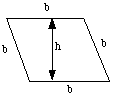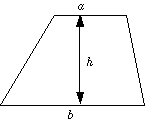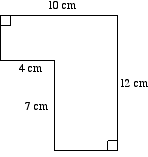The area of a polygon, such as a rectangle, is the amount of space enclosed by the polygon.
Units
The units used for measuring areas depends on the units used for measuring the length of the shape.
A square metre is the area occupied by a square with each side 1 metre long. It is written as 1 m2.
A hectare is the area enclosed by a square with sides of length 100 metres
Other common units for area are:
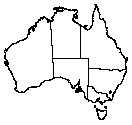 |
||
Converting between units
To convert between units of area is sometimes confusing. A diagram often helps.
e.g.
| Convert 1 m2 into cm2. |
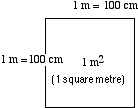 |
From the diagram |
Area Formulae
|
Shape
|
||
 |
A = length × width = l2 |
|
 |
A = base × height = b × h = bh |
|
 |
A = half × base × height = 1⁄2 × b × h |
|
|
|
A = base × height = bh |
|
|
|
A = base × height = b × h or A = 1⁄2 × (product of length of diagonals) |
|
|
|
A = 1⁄2 × ( a + b ) × h
|
Composite Shapes
Composite shapes are shapes made up of shapes such as squares rectangles, semicircles etc.
To find out the area of composite shapes, break the larger shape up into smaller ones for which you can find the area.
Example
|
Find the area of the followingcomposite shape:
|
Break the shape up into two rectangles and find the missing measurements
Area of shape = area of A + area of B = 10 × 5 + 7 × 6 = 92 cm2 |
Note: The shape could have been broken up into two different rectangles using a vertical line.
The problem could also have been done by calculating the area of the larger rectangle and subtracting the corner that is missing.
Area of shape = 10 × 12 − 4 × 7
= 120 − 28
= 92 cm2

